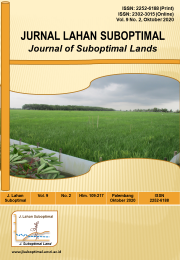Effect of Plant Gowth Regulator on The Gowth of Zygotic Embryos in Three Types of Oil Palm Fruit (Elaeis guineensis Jacq.) in Tissue Culture
DOI:
https://doi.org/10.33230/JLSO.9.2.2020.474Keywords:
oil palm, in vitro, dura, pisifera, teneraAbstract
Surahman H, Sulaksono G, Sembiring Z, Kurnianingsih A, Priadi DP, Asmono D. 2020. Effect of plant gowth regulator on the gowth of zygotic embryos in three types of oil palm fruit (Elaeis guineensis Jacq.) in tissue culture. Jurnal Lahan Suboptimal : Journal of Suboptimal Lands 9(2): 149-159.
Embryo culture is a widely used and effective way of overcoming the dormancy nature of seeds in oil palm. At the germination stage, the influence of gowth regulators play an important role although in relatively lower concentrations in the germination media. This aim research determined the effect of adding various concentrations of gowth regulator on the three types of oil palm fruit based on the thickness of the shell. This research carried out at the Tissue Culture Laboratory of PT. Sampoerna Ago Tbk. from September 2018 to January 2019. The gowth regulator substances used in this study were NAA, BAP and GA3. The composition of the gowth regulators used were H1 = 0.05 mg/L NAA + 0.1 mg/L BAP + 0.1 mg/L GA3, H2 = 0.05 mg/L NAA + 0.3 mg/L BAP + 0.1 mg/L GA3, H3 = 0.05 mg/L NAA + 0.5 mg/L BAP + 0.1 mg/L GA3 and H4 = No gowth regulator. While the types of oil palm fruit used were C1 = Dura, C2 = Tenera and C3 = Pisifera. This research used a factorial complete randomized design with three replications. The results showed that in general the use of gowth regulator substances H1 = 0.05 mg/L NAA + 0.1 mg/L BAP + 0.1 mg/L GA3 and the type of dura fruit showed positive results based on viability, scoring, survival and height of plantlets when compared with other treatments.
Downloads
Published
How to Cite
Issue
Section
License
Copyright (c) 2020 Hadi Surahman, Gogoh Sulaksono, Zulhermana Sembiring, Astuti Kurnianingsih, Dwi Putro Priadi, Dwi Asmono

This work is licensed under a Creative Commons Attribution-NonCommercial-ShareAlike 4.0 International License.













